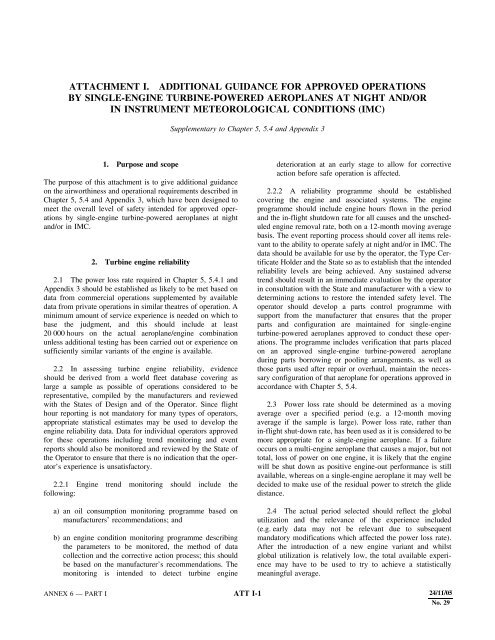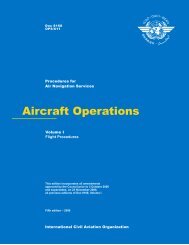Operation of Aircraft
Annex 6, Part I
Annex 6, Part I
- No tags were found...
Create successful ePaper yourself
Turn your PDF publications into a flip-book with our unique Google optimized e-Paper software.
ATTACHMENT I. ADDITIONAL GUIDANCE FOR APPROVED OPERATIONS<br />
BY SINGLE-ENGINE TURBINE-POWERED AEROPLANES AT NIGHT AND/OR<br />
IN INSTRUMENT METEOROLOGICAL CONDITIONS (IMC)<br />
Supplementary to Chapter 5, 5.4 and Appendix 3<br />
1. Purpose and scope<br />
The purpose <strong>of</strong> this attachment is to give additional guidance<br />
on the airworthiness and operational requirements described in<br />
Chapter 5, 5.4 and Appendix 3, which have been designed to<br />
meet the overall level <strong>of</strong> safety intended for approved operations<br />
by single-engine turbine-powered aeroplanes at night<br />
and/or in IMC.<br />
2. Turbine engine reliability<br />
2.1 The power loss rate required in Chapter 5, 5.4.1 and<br />
Appendix 3 should be established as likely to be met based on<br />
data from commercial operations supplemented by available<br />
data from private operations in similar theatres <strong>of</strong> operation. A<br />
minimum amount <strong>of</strong> service experience is needed on which to<br />
base the judgment, and this should include at least<br />
20 000 hours on the actual aeroplane/engine combination<br />
unless additional testing has been carried out or experience on<br />
sufficiently similar variants <strong>of</strong> the engine is available.<br />
2.2 In assessing turbine engine reliability, evidence<br />
should be derived from a world fleet database covering as<br />
large a sample as possible <strong>of</strong> operations considered to be<br />
representative, compiled by the manufacturers and reviewed<br />
with the States <strong>of</strong> Design and <strong>of</strong> the Operator. Since flight<br />
hour reporting is not mandatory for many types <strong>of</strong> operators,<br />
appropriate statistical estimates may be used to develop the<br />
engine reliability data. Data for individual operators approved<br />
for these operations including trend monitoring and event<br />
reports should also be monitored and reviewed by the State <strong>of</strong><br />
the Operator to ensure that there is no indication that the operator’s<br />
experience is unsatisfactory.<br />
2.2.1 Engine trend monitoring should include the<br />
following:<br />
a) an oil consumption monitoring programme based on<br />
manufacturers’ recommendations; and<br />
b) an engine condition monitoring programme describing<br />
the parameters to be monitored, the method <strong>of</strong> data<br />
collection and the corrective action process; this should<br />
be based on the manufacturer’s recommendations. The<br />
monitoring is intended to detect turbine engine<br />
deterioration at an early stage to allow for corrective<br />
action before safe operation is affected.<br />
2.2.2 A reliability programme should be established<br />
covering the engine and associated systems. The engine<br />
programme should include engine hours flown in the period<br />
and the in-flight shutdown rate for all causes and the unscheduled<br />
engine removal rate, both on a 12-month moving average<br />
basis. The event reporting process should cover all items relevant<br />
to the ability to operate safely at night and/or in IMC. The<br />
data should be available for use by the operator, the Type Certificate<br />
Holder and the State so as to establish that the intended<br />
reliability levels are being achieved. Any sustained adverse<br />
trend should result in an immediate evaluation by the operator<br />
in consultation with the State and manufacturer with a view to<br />
determining actions to restore the intended safety level. The<br />
operator should develop a parts control programme with<br />
support from the manufacturer that ensures that the proper<br />
parts and configuration are maintained for single-engine<br />
turbine-powered aeroplanes approved to conduct these operations.<br />
The programme includes verification that parts placed<br />
on an approved single-engine turbine-powered aeroplane<br />
during parts borrowing or pooling arrangements, as well as<br />
those parts used after repair or overhaul, maintain the necessary<br />
configuration <strong>of</strong> that aeroplane for operations approved in<br />
accordance with Chapter 5, 5.4.<br />
2.3 Power loss rate should be determined as a moving<br />
average over a specified period (e.g. a 12-month moving<br />
average if the sample is large). Power loss rate, rather than<br />
in-flight shut-down rate, has been used as it is considered to be<br />
more appropriate for a single-engine aeroplane. If a failure<br />
occurs on a multi-engine aeroplane that causes a major, but not<br />
total, loss <strong>of</strong> power on one engine, it is likely that the engine<br />
will be shut down as positive engine-out performance is still<br />
available, whereas on a single-engine aeroplane it may well be<br />
decided to make use <strong>of</strong> the residual power to stretch the glide<br />
distance.<br />
2.4 The actual period selected should reflect the global<br />
utilization and the relevance <strong>of</strong> the experience included<br />
(e.g. early data may not be relevant due to subsequent<br />
mandatory modifications which affected the power loss rate).<br />
After the introduction <strong>of</strong> a new engine variant and whilst<br />
global utilization is relatively low, the total available experience<br />
may have to be used to try to achieve a statistically<br />
meaningful average.<br />
ANNEX 6 — PART I ATT I-1 1/11/01 24/11/05<br />
No. 29












